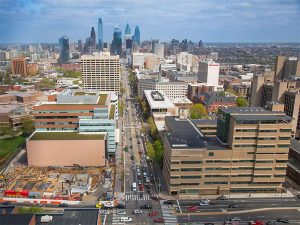The “Live-Work-Play Vibe” in University City
 |
| Photo courtesy of Philly.com |
The reason I have “Live-Work-Play Vibe” in quotes, is because it was not my wording; but that from this article with Stephen Tang, CEO of the Science Center.
Live-Work-Play has been a common theme in urban areas across the US for the last decade or so. It symbolizes a lifestyle where local residents can live in a great neighborhood, get to work easily, and go out for drinks/dinner/shopping in the same neighborhood as both their home and job. Basically, it means that you have more free time to enjoy your life, rather than commute a long way to work or drive a far distance for entertainment.
This is the lifestyle you get whether you live in Center City, University City, or any other dense Philadelphia neighborhood. It’s a major reason why more people are choosing to live in cities today than in years past, and it’s also why Philadelphia is doing so well as a desirable place to live. Our city is designed to support that kind of lifestyle (e.g. dense, vertical, walkable, etc), and the infrastructure is there to build on it even more.
Once you think about it, the suburban lifestyle was built on the opposite: get a single family house with a yard, create space between you and your neighbors, and then park in your driveway/garage so that you can easily drive to work, the supermarket, the mall, Walmart, Target, you name it. It’s the complete opposite of the urban lifestyle.
Now to be honest and upfront, I personally do not feel that one is better than the other, as many different people have many different ideas/opinions on how to live their lives. I think there are pros and cons to both ways of life. Therefore, there is plenty of room for either lifestyle to exist in most large US metropolitan areas.
I have also helped both buyers and sellers in Philadelphia’s city proper, as well as in suburban Philadelphia, so I understand both sides and why people choose one over the other. Lastly, I have lived in both environments myself.
Alright, back to UCity and the Science Center.
To put things in perspective, the Science Center today has 17 buildings across 17 acres of land. It is considered to be the “oldest and largest urban research park in the US,” establishing itself in 1963. It currently employs 15,000 people, contributes almost $65M in tax revenue, and provides Philadelphia start-ups with the office and lab space they need to get their ideas off the ground.
In other words, the Science Center is a very large incubator.
If what you just read about SC isn’t large and significant enough for you, the organization plans to double in size over the next 10 years. The plan is to partner up with Wexford Science + Technology, expand to 4M square feet of office/lab/residential/retail, re-imagine the former University City High School, and build on additional open parcels to increase the size of the current campus.
Suh-weet.
I know, I know. When things are good in real estate (as well as in the general economy) grand visions seem to emerge everyday. We will build this, it will be the best ever, and people will come to us.
This project is different, and it’s planned around consistent/well-thought-out concepts: Philadelphia has many local universities and hospitals that can support this type of project, people around the world are just starting to discover how conveniently located Philadelphia actually is (to other major US markets, as well as its ease of access to the rest of the world), and Philadelphia is slowly becoming one of the top US hubs for the life sciences.
More information about the Science Center here, and more information about their growth plans here.

